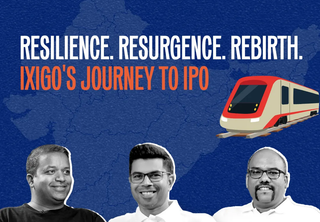Consumer Brand IPOs Post 2020
Our learnings from post-2020 IPOs of Consumer Brands
Consumer Brand IPOs Post 2020
Our learnings from post-2020 IPOs of Consumer Brands
We are at a very special crossroads in India as we await the first set of new-age, online-first consumer brands to go public soon. The last three years have seen D2C brands proliferate and gather significant investor interest. As a fund, we have been strong believers in new age Consumer Brands that are being built out of India, and have invested over $150M+ in the space so far.
As we meet hundreds of founders in this space every month, we have seen some questions pop up repeatedly in those conversations. Some of them include:
- What is the typical IPO scale and what is the expected rate of growth?
- Does profitability matter? To what extent?
- When should I think about going omnichannel?
- What kind of revenue & EBITDA multiples should I expect?
- Hence, what implications does this have on company-building in the sector?
So we decided to study newly listed stocks in India and USA to find some of these answers. We narrowed our focus down to some brands that went public post 2020 - 10 in India and 9 in the US. This analysis gave us some very interesting observations that we have tried to capture in this post.
So sit back, relax, and feel free to take notes. But first, let us set the context for you in terms of the companies we have covered and some terminology / definitions.

.
As the first step, we wanted to figure out the scale and valuations of companies at the time of IPO. The average Indian company in our set had a revenue of ~$100M at the time of public listing and was valued ~$900M. In fact, 4 out of 10 Indian companies in our set were able to go public at IPO valuations <$500M, which is a fantastic signal for founders creating new-age brands. The revenue scale of US brands was much larger, and they were also growing faster, but profitability was significantly better in India and revenue multiples in both markets were quite comparable. (More Below)
.

SUMMARISING SOME KEY OBSERVATIONS
- The US universe is D2C heavy whereas the Indian universe is offline heavy
- For US Consumer Brands:
- COVID tailwind in periods prior to public listing drove stronger than expected growth in the US; over time, things rationalized as offline opened, and growth rates dropped dramatically
- Meta + Apple algorithm changes and market cluttering have made it difficult to target customers sharply and hence there is a secular increase in CAC for the US companies (1.5-2x)
- Lower operating leverage on D2C made it harder to become profitable
- Hims & Hers stock has performed the best among US listed Consumer Companies -> subscription model and improving profitability (-4% Adj EBITDA margin last quarter) with ~100% YoY growth
- Stocks of companies in the Indian universe despite being offline heavy have done quite well.
- Average Indian company in our universe grew 31.5% YoY, delivered 15.8% EBITDA Margin and was valued at 42X EV / TTM EBITDA, implying TTM revenue multiple of 7.3X (median for the set was 6.6X).
HENCE, WHAT WE FEEL COULD BE IMPLICATIONS FOR BUILDING BRANDS IN INDIA?
Type of public listings that Indian investors have liked so far:
- Revenue scale in the vicinity of $100Mn and beyond
- Profitable and ideally generates 15-20% EBITDA
- Businesses hitting the above have been able to command a 6-8x revenue multiple or ~40-50x EBITDA multiple
- Growth > 30-35% YoY may imply even richer multiples, but should not come at the expense of profitability
What could it mean for company-building?
- Given profitability is super important, and it is hard to achieve $100 Mn D2C scale in India (except in very high-frequency categories - milk, meats etc.), companies will have to build a presence on & dominate Compounding Channels (EBOs, General Trade or even marketplaces in some categories)
- Compounding Channels -> characterized by operating leverage (on rent & manpower in EBOs, on sales team costs & visibility expenses in GT, by virtue of reviews & ratings on marketplaces)
- D2C & Modern Trade are not compounding channels; rather, cost structures start getting more expensive with increasing scale (higher CAC, similar commissions despite lower throughput in middle / bottom of the pack stores)
- However, D2C will still be the best starting point because:
- Superior customer experience allows the brand journey to be short-circuited + faster feedback loops
- Journey to first $20-30 Mn revenue scale is significantly faster and far more capital efficient
- Obsess over retention & LTV / CAC in early days of D2C (signal for depth of pain point, differentiation & brand strength)
We hope the post was useful. If you're building in the space or are curious to chat more about this article, please feel free to write to us at harsh@elevationcapital.com and/or chirag@elevationcapital.com :)
Written by Chirag Chadha
Related

Our New Fund: All In on India
Elevation Capital announces Fund VIII of $670 million, to accelerate partnering with category defining early stage companies in India
07.04.2022

Investing in PierSight
Building the Future of Global-Scale Earth Monitoring
12.01.2024

Resilience, Resurgence, Rebirth: ixigo's Journey
Aloke Bajpai and Rajnish Kumar, Co-founders, ixigo
24.06.2024